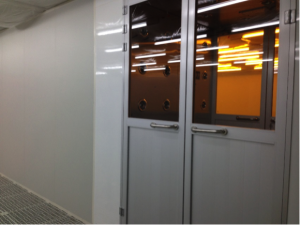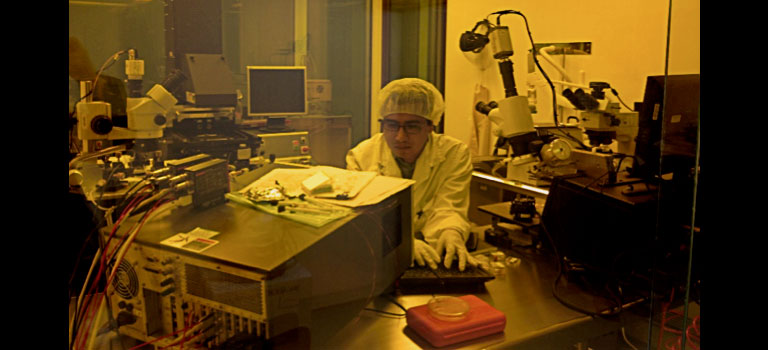By Diana Maricruz Pérez Santos
“Cleanroom” is the term employed to classify workspaces which feature controlled atmosphere in order to have a specific range on the amount of particles in the environment. This results in a workspace with very low levels of environmental pollutants. Here we’ll talk a little about this new trend in research centers and industries, and how they can be useful in food science.
Functional principle
The existence of processes that are highly susceptible to environmental contaminants are the reason to develop this type of workspace. Essentially, a cleanroom is designed to remove as much as possible of some nanoscopic and microscopic floating particles from the structural materials of the room, people, equipment and tools inside the workplace. We define nanoscopic and microscopic as particles floating in the atmosphere; everything alive and not alive that has a Brownian motion (random movement within a fluid) within these ranges.
Very similar to air curtains at the entrance of supermarkets, cleanrooms use a system to filter and introduce clean air inside them. There is talk of a laminar flow (orderly flow) of sterile air that passes through the room side to side, which constantly stirs and filters unwanted particles with each cycle. Design specifications and features are defined according to the requirements of the work area. The ISO 14644 standard concerning this divides cleanrooms into different classes according to the number of particles per cubic meter of atmosphere.
 Cleanroom air shower
Cleanroom air shower
Applications in food
Despite the high cost of a workspace with these characteristics, it is believed that with a prolonged period of application this technology could be a very good investment in the food industry. Compared with other scientific applications such as microarrays for genetic studies, food researchers develop projects in relatively short time and in most cases with an immediate commercial application. Regarding the industrial use of cleanrooms, the largest advantage is focused on elimination of critical control points of the process.
Especially important problems related to cleanrooms in the food area are: reduction of microbial count, longer shelf life, preservatives and additives, decreased handling of prepared food for immediate consumption, reducing cross-contamination and toxicology outbreaks, meat industry implementation and food packaging.
While considered fairly new technology, cleanrooms generate a lot of buzz. We will just have to wait to see its true benefits.

Construction of a new cleanroom (Note the holes in the floor for airflow)
Acknowledgements: I want to thank the Center for Micro and Nanosciences and Nanotechnologies from the Instituto Politecnico Nacional or NCWC-IPN (Spanish abbreviation) in Mexico City for their assistance on this post. The NCWC-IPN provides characterization of samples with latest analytical equipment to educational institutions, researchers and companies in Mexico and abroad.
Photos credits: Centro de Nanociencias y Micro y Nanotecnologías del Instituto Politécnico Nacional (CNMN-IPN)
http://www.nanocentro.ipn.mx/WPS/WCM/CONNECT/NANOCENT/CNMN/INICIO/INDEX.HTM






Es bueno saber y leer estos tipo de articulos de investigacion. Ya que sinceramente por dar un ejemplo : no sabia que las cortinas de aire en la entra de las supermercados es para crear un aire mas libre de agentes contaminantes que atacan a los alimentos. Ya que otra persona puedo creer que es para refrescarte. Que ingenuo pueden o podemos ser. Pero la verdad es que no analizamos y no vemos todo el panorama o el diseño de ingenieria a gran escala.
Sin mas que decir. Gracias por el espació
Hi, thanks for sharing your comment. I know that new smartphones translate web pages automatically to our native language and sometimes that could make confusion. Please can you write on English your comments? for respect to others readers.We will appreciate a lot.